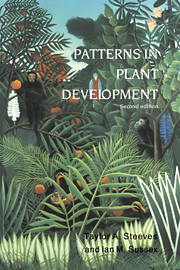Book contents
- Frontmatter
- Contents
- Preface
- Acknowledgments
- 1 Development in the vascular plants
- 2 Embryogenesis: beginnings of development
- 3 Analytical and experimental studies of embryo development
- 4 The structure of the shoot apex
- 5 Analytical studies of the shoot apex
- 6 Experimental investigations on the shoot apex
- 7 Organogenesis in the shoot: leaf origin and position
- 8 Organogenesis in the shoot: determination of leaves and branches
- 9 Organogenesis in the shoot: later stages of leaf development
- 10 Determinate shoots: thorns and flowers
- 11 The development of the shoot system
- 12 The root
- 13 Differentiation of the plant body: the origin of pattern
- 14 Differentiation of the plant body: the elaboration of pattern
- 15 Secondary growth: the vascular cambium
- 16 Secondary growth: experimental studies on the cambium
- 17 Alternative patterns of development
- Credits
- Author index
- Subject index
15 - Secondary growth: the vascular cambium
Published online by Cambridge University Press: 21 December 2009
- Frontmatter
- Contents
- Preface
- Acknowledgments
- 1 Development in the vascular plants
- 2 Embryogenesis: beginnings of development
- 3 Analytical and experimental studies of embryo development
- 4 The structure of the shoot apex
- 5 Analytical studies of the shoot apex
- 6 Experimental investigations on the shoot apex
- 7 Organogenesis in the shoot: leaf origin and position
- 8 Organogenesis in the shoot: determination of leaves and branches
- 9 Organogenesis in the shoot: later stages of leaf development
- 10 Determinate shoots: thorns and flowers
- 11 The development of the shoot system
- 12 The root
- 13 Differentiation of the plant body: the origin of pattern
- 14 Differentiation of the plant body: the elaboration of pattern
- 15 Secondary growth: the vascular cambium
- 16 Secondary growth: experimental studies on the cambium
- 17 Alternative patterns of development
- Credits
- Author index
- Subject index
Summary
In considering the apical or primary meristems of the plant body, one of the most perplexing problems is the permanently meristematic condition of these regions, which are somehow spared from the processes of maturation occurring in their derivatives. One might be tempted to relate this property to their terminal position, their three-dimensional mass, or their organization, which is distinct from that of the mature structures they produce. However, the lateral meristems, which share the capacity for continued growth but are strikingly different in every other respect, prevent an easy acquiescence to this temptation. The vascular cambium and the cork cambium, or phellogen, are lateral in position, have the form of cylindrical sheets encircling the plant axis, and are organized in close conformity with the tissues to which they give rise. They initiate only specific tissues rather than whole organs as in the case of the terminal meristems. Furthermore, it must be borne in mind that whereas every vascular plant body must have terminal meristems in order to exist at all, the lateral meristems have a supplemental role and are by no means universal (Barghoorn, 1964).
THE INITIATION OF CAMBIAL ACTIVITY
Nothing emphasizes the differences between primary and secondary meristems more effectively than a consideration of the origin of the vascular cambium. Whereas the shoot and root apical meristems are initiated among the cells of the embryo early in the development of the plant, the cambium has its origin from a partially differentiated vascular tissue, the procambium.
- Type
- Chapter
- Information
- Patterns in Plant Development , pp. 311 - 332Publisher: Cambridge University PressPrint publication year: 1989
- 1
- Cited by

